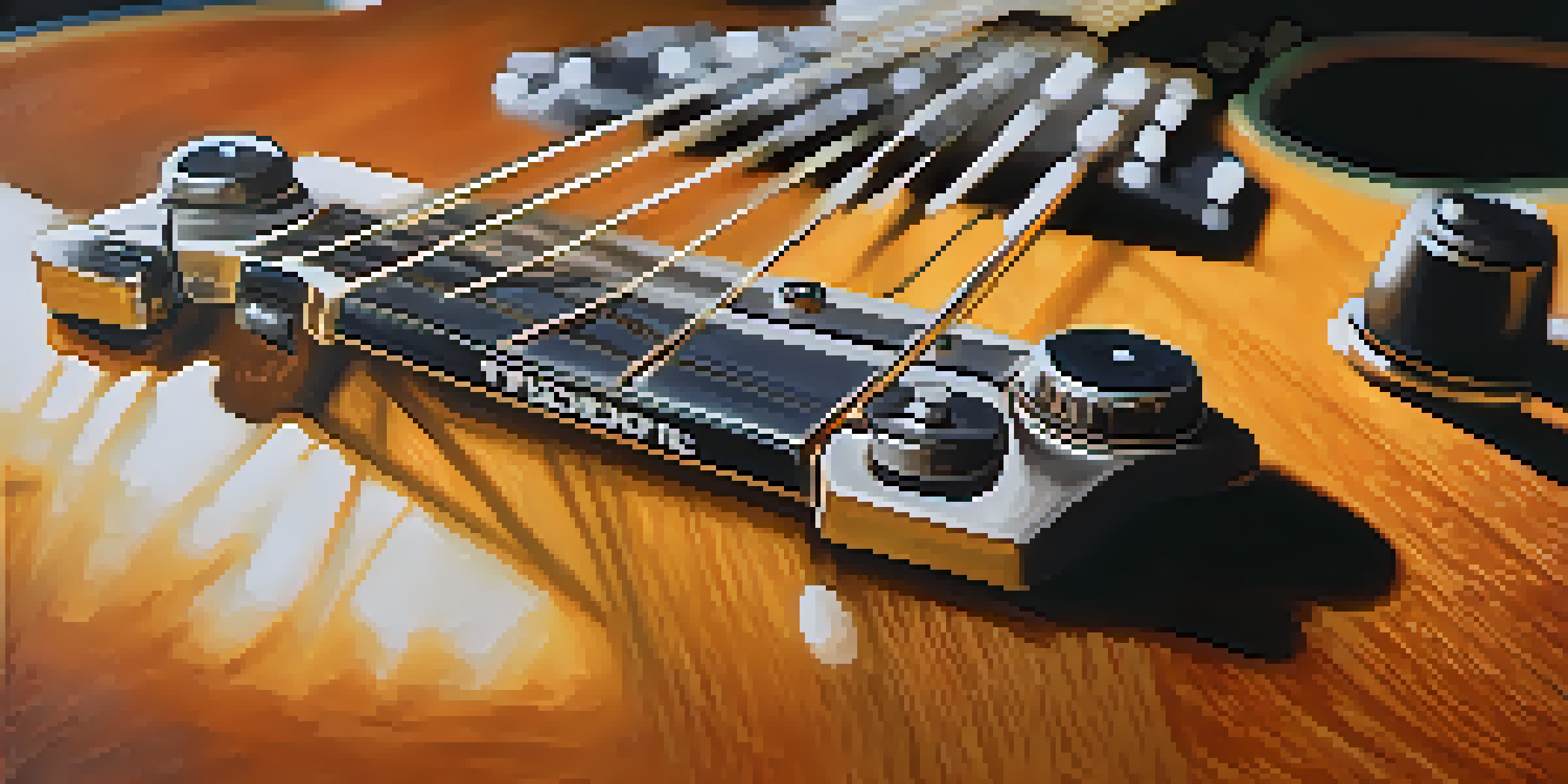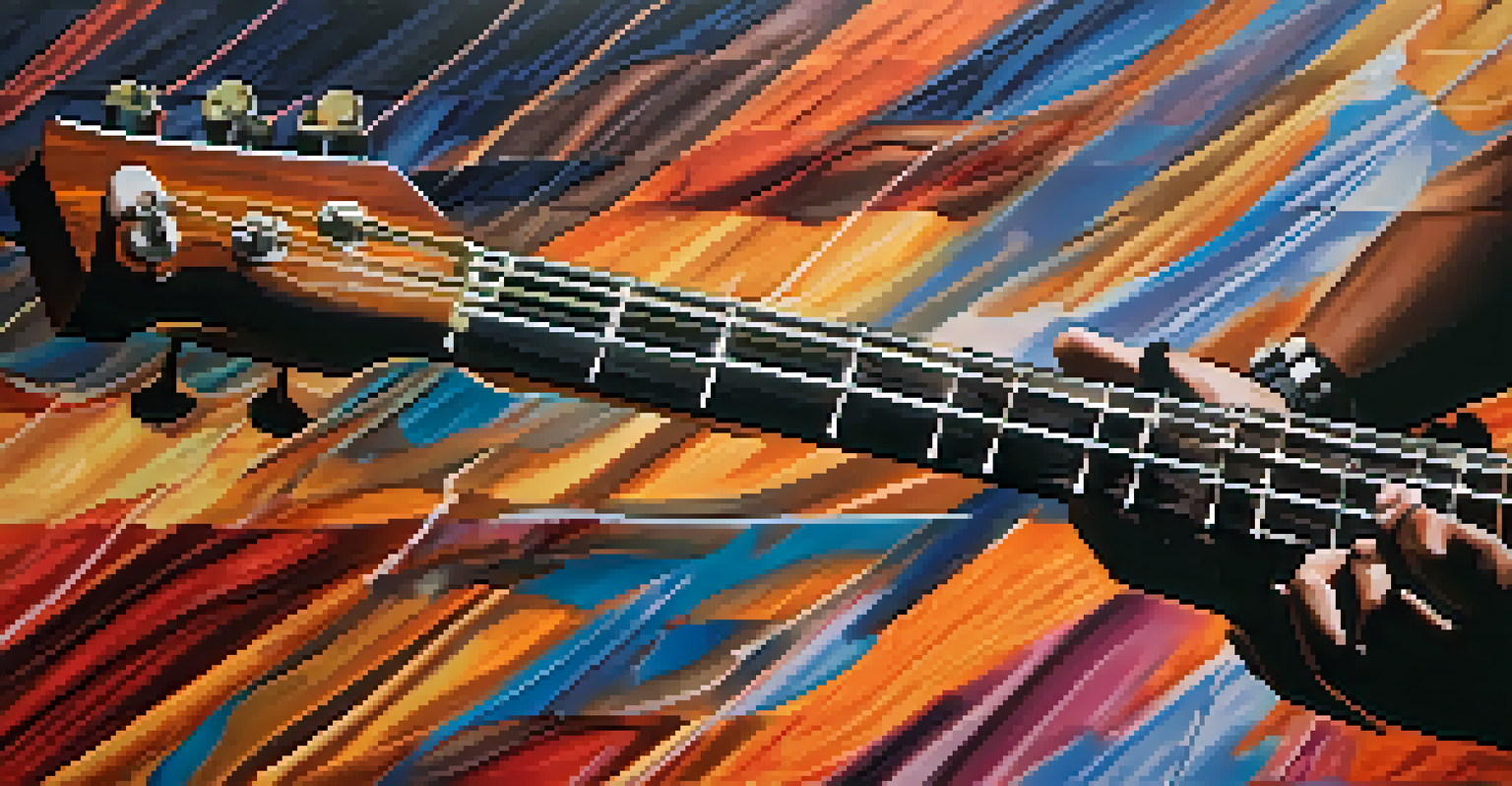Blues Guitar Improvisation Techniques for Expressive Playing

Understanding the Blues Scale for Improvisation
The blues scale is the backbone of blues improvisation, providing a framework for expressive solos. It typically consists of six notes, including the root, flat third, fourth, flat fifth, fifth, and flat seventh. Mastering this scale allows you to create melodies that resonate deeply with the emotional essence of blues music.
The blues is like a woman. You know, it’s like you can’t get away from it. It’s a feeling that you have to live with.
To visualize the scale, think of it as a staircase, where each step represents a note. As you practice ascending and descending this scale, you’ll begin to feel the natural flow of the music. This familiarity helps you break free from rigid patterns, allowing your creativity to shine through in your improvisations.
Incorporating the blues scale into your playing is about more than just hitting the right notes; it’s about feeling the music. Listen to how your favorite blues guitarists use this scale, and let it inspire your own improvisational style.
Using Bends and Slides for Expressive Phrasing
Bends and slides are essential techniques that add expressiveness to your guitar solos. A bend involves pushing a string to raise its pitch, creating a vocal-like quality that can evoke strong emotions. Similarly, sliding between notes provides a smooth, gliding effect that can make your playing feel more fluid and dynamic.

For example, when playing a note, try bending it up a whole step before returning to the original pitch. This technique mimics the human voice and can be particularly powerful when used during climactic moments in your solo. Experiment with different types of bends and slides to see how they change the character of your playing.
Master the Blues Scale for Emotion
Understanding and practicing the blues scale enables you to create deeply resonant melodies in your improvisation.
Remember, the goal is to tell a story with your guitar. Each bend and slide adds a chapter to your narrative, allowing listeners to connect with your emotions on a deeper level.
Incorporating Call and Response Techniques
Call and response is a traditional technique in blues music that mimics conversation. In this context, your 'call' is a musical phrase, while the 'response' is another phrase that complements or contrasts it. This interaction creates a dynamic exchange that keeps your improvisation engaging and lively.
Improvisation is the ability to create something out of nothing while playing an instrument.
Think of it like having a dialogue with your audience or fellow musicians. You play a line, and then you either repeat it with variations or follow it up with something unexpected. This back-and-forth not only showcases your creativity but also invites listeners to participate in the musical conversation.
To practice this technique, listen to classic blues recordings and pay attention to how artists use call and response. Try to replicate this in your own playing, and soon you’ll find it becomes a natural part of your improvisational style.
Exploring Rhythm and Timing in Improvisation
Rhythm is just as important as melody in blues guitar improvisation. The way you play a note—its duration and placement—can significantly impact the feel of your solo. By experimenting with different rhythms, you can add depth and excitement to your playing.
For instance, try playing a phrase with a syncopated rhythm, where you emphasize off-beat notes. This technique can create a sense of tension and release, making your improvisation more captivating. Additionally, don’t be afraid to vary your timing; playing slightly behind or ahead of the beat can add a unique groove.
Enhance Solos with Expressive Techniques
Using bends, slides, and vibrato can significantly elevate the emotional impact of your guitar solos.
Ultimately, finding your rhythmic voice is about practice and exploration. Play along with different backing tracks and styles to discover how rhythm can transform your improvisational approach.
Adding Vibrato for Emotional Impact
Vibrato is a subtle yet powerful technique that can enhance the emotional quality of your solos. By gently oscillating the pitch of a note, you create a rich, singing tone that draws listeners in. It’s often the difference between a good note and a great note, elevating your playing to new heights.
To practice vibrato, focus on maintaining a steady hand while applying slight pressure on the string. Experiment with different speeds and widths of vibrato, as these variations can evoke different feelings. A slow, wide vibrato might convey sadness, while a fast, narrow vibrato can express excitement.
Incorporating vibrato into your playing is all about subtlety. Use it sparingly to emphasize key notes in your improvisation, allowing your audience to feel the intensity of your emotions.
Utilizing Arpeggios for Melodic Interest
Arpeggios, which are chords played one note at a time, can add melodic interest to your solos. Instead of just sticking to scales, incorporating arpeggios allows you to outline the harmonic structure of the music, creating a richer and more diverse sound. This technique helps you break away from predictable patterns and keeps your improvisation fresh.
To start, practice playing the arpeggios of the chords used in your backing tracks. Focus on smooth transitions between notes, and listen to how they interact with the underlying harmony. You might find that certain arpeggios resonate well with specific scales, creating beautiful melodic lines.
Develop Your Unique Guitar Voice
Experimenting with various techniques helps you discover and refine your personal style in blues improvisation.
As you gain confidence, try integrating arpeggios into your improvisation. This will not only enhance your musical vocabulary but also deepen your understanding of how chords and melody work together in blues music.
Experimenting with Different Techniques for Personal Style
Every guitarist has a unique voice, and experimentation is key to discovering yours. Don’t be afraid to try out various techniques, blending them into your playing to see what resonates with you. Whether it’s fingerpicking, hybrid picking, or using a slide, exploring new methods can lead to exciting developments in your improvisation.
For instance, you might find that incorporating fingerpicking adds a different texture to your solos, while using a slide gives your notes a haunting quality. The beauty of blues guitar lies in its flexibility; there are no strict rules, only guidelines that can inspire your creativity.

As you experiment, keep a journal of your favorite techniques and discoveries. Over time, you'll develop a personal style that reflects who you are as a musician, making your improvisations truly expressive.